Class 10 SELINA Solutions Maths Chapter 16 - Loci (Locus and its Constructions)
Loci (Locus and its Constructions) Exercise Ex. 16(A)
Solution 2
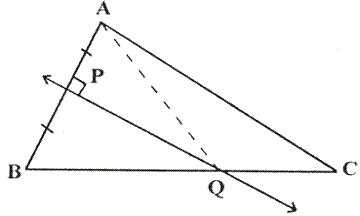
Construction: Join AQ
Proof: In ![]() and
and ![]() ,
,
AP = BP (given)
![]() (Each = 90
(Each = 90![]() )
)
PQ = PQ (Common)

Hence Q is equidistant from A and B.
Solution 3
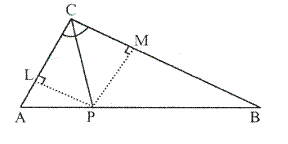
Construction: From P, draw ![]() and
and ![]()
Proof: In ![]() and
and ![]() ,
,

Hence, P is equidistant from AC and BC
Solution 4
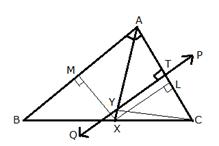
Construction: From X, draw ![]() and
and ![]() . Also join YC.
. Also join YC.
Proof:
i) In ![]() and
and ![]() ,
,

Hence, X is equidistant from AB and AC.
ii) In ![]() and
and ![]() ,
,

Hence, Y is equidistant from A and C.
Solution 5
Given: In triangle ABC, AB = 4.2 cm, BC = 6.3 cm and AC = 5 cm
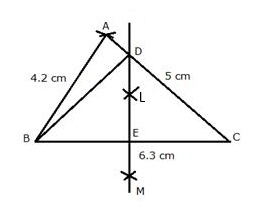
Steps of Construction:
i) Draw a line segment BC = 6.3 cm
ii) With centre B and radius 4.2 cm, draw an arc.
iii) With centre C and radius 5 cm, draw another arc which intersects the first arc at A.
iv) Join AB and AC.
![]() is the required triangle.
is the required triangle.
v) Again with centre B and C and radius greater than ![]() , draw arcs which intersects each other at L and M.
, draw arcs which intersects each other at L and M.
vi) Join LM intersecting AC at D and BC at E.
vii) Join DB.
Proof: In ![]() and
and ![]()

Hence, D is equidistant from B and C.
Solution 6
Construction: Join PQ which meets AB in D.
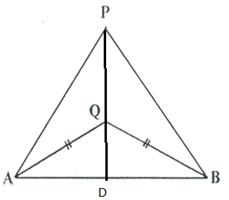
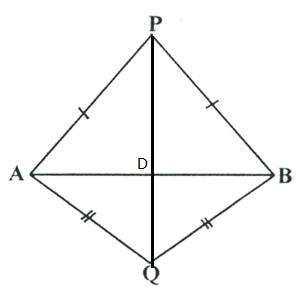
Proof: P is equidistant from A and B.
![]() P lies on the perpendicular bisector of AB.
P lies on the perpendicular bisector of AB.
Similarly, Q is equidistant from A and B.
![]() Q lies on perpendicular bisector of AB.
Q lies on perpendicular bisector of AB.
![]() P and Q both lie on the perpendicular bisector of AB.
P and Q both lie on the perpendicular bisector of AB.
![]() PQ is perpendicular bisector of AB.
PQ is perpendicular bisector of AB.
Hence, locus of the points which are equidistant from two fixed points, is a perpendicular bisector of the line joining the fixed points.
Solution 7
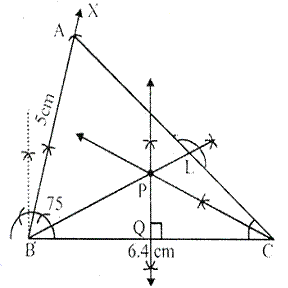
Steps of Construction:
i) Draw a line segment BC = 6.4 cm
ii) At B, draw a ray BX making an angle of ![]() with BC and cut off BA = 5 cm.
with BC and cut off BA = 5 cm.
iii) Join AC.
![]() is the required triangle.
is the required triangle.
iv) Draw the perpendicular bisector of BC.
v) Draw the angle bisector of angle ACB which intersects the perpendicular bisector of BC at P.
vi) Join PB and draw ![]() .
.
Proof: In ![]() and
and ![]()

Hence, P is equidistant from B and C.
Again in ![]() and
and ![]()

Hence, P is equidistant from AC and BC.
Solution 8
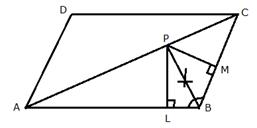
Construction: From P, draw ![]() and
and ![]()
Proof: In ![]() and
and ![]()

Hence, P is equidistant from AB and BC.
Solution 9
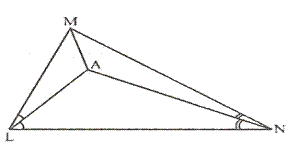
Construction: Join AM
Proof:
![]() A lies on bisector of
A lies on bisector of ![]()
![]() A is equidistant from MN and LN.
A is equidistant from MN and LN.
Again, A lies on bisector of ![]()
![]() A is equidistant from LN and LM.
A is equidistant from LN and LM.
Hence, A is equidistant from all sides of the triangle LMN.
Also, A is equidistant from MN and LM.
![]() A lies on the bisector of
A lies on the bisector of ![]()
Solution 10
Steps of construction:
(i)Draw line BC = 6 cm and an angle CBX = 60o. Cut off AB = 3.5. Join AC, triangle ABC is the required triangle.
(ii) Draw the angle bisector of angle B
(iii) Draw the perpendicular bisector of BC
(iiv)Bisector of angle B meets bisector of BC at P.
![]() BP is the required length, where, PB = 3.5 cm
BP is the required length, where, PB = 3.5 cm
P is the point which is equidistant from BA and BC, also equidistant from B and C.
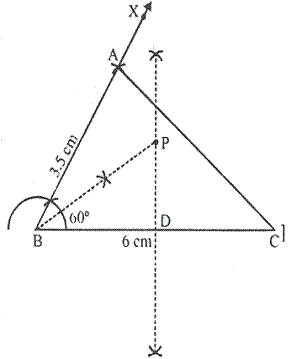
PB=3.6 cm
Loci (Locus and its Constructions) Exercise TEST YOURSELF
Solution 2
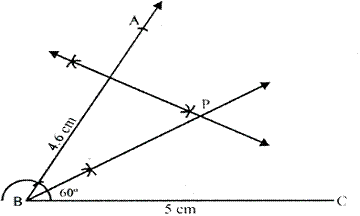
Steps of Construction:
i) Draw a line segment BC = 5 cm
ii) At B, draw a ray BX making an angle of ![]() and cut off BA = 4.6 cm.
and cut off BA = 4.6 cm.
iii) Draw the angle bisector of ![]() .
.
iv) Draw the perpendicular bisector of AB which intersects the angle bisector at P.
P is the required point which is equidistant from AB and BC, as well as from A and B.
Solution 3
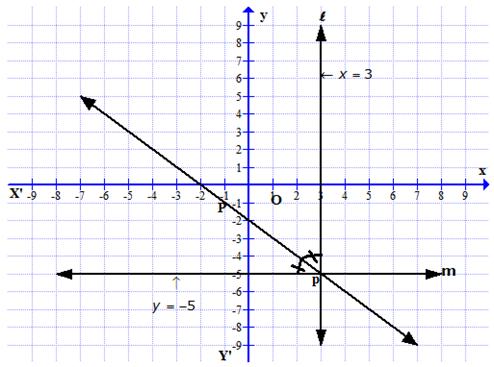
On the graph, draw axis XOX’ and YOY’
Draw a line l, x = 3 which is parallel to y-axis
And draw another line m, y = -5, which is parallel to x-axis
These two lines intersect each other at P.
Now draw the angle bisector p of angle P.
Since p is the angle bisector, any point on p is equidistant from l and m.
Therefore, this line p is equidistant from l and m.
Solution 4
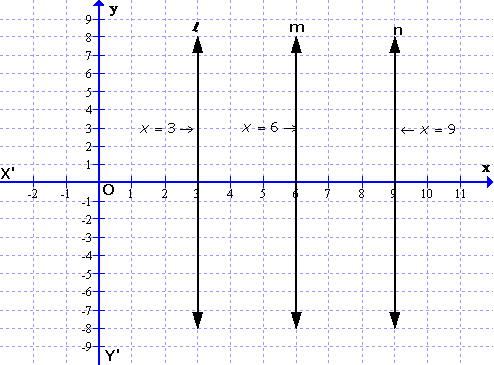
On the graph, draw axis XOX’ and YOY’
Draw a line m, x = 6 which is parallel to y-axis
Take points P and Q which are at a distance of 3 units from the line m.
Draw lines l and n from P and Q parallel to m
With locus = 3, two lines can be drawn x = 3 and x = 9.
Solution 5
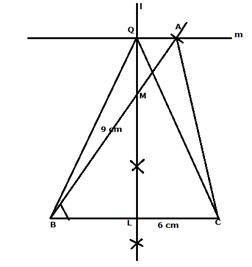
Steps of Construction:
(i) Draw a line segment BC = 6 cm.
(ii) At B, draw a ray BX making an angle 60 degree and cut off BA=9 cm.
(iii) Join AC. ABC is the required triangle.
(iv) Draw perpendicular bisector of BC which intersects BA in M, then any point on LM is equidistant from B and C.
(v) Through A, draw a line m || BC.
(vi) The perpendicular bisector of BC and the parallel line m intersect each other at Q.
(vii) The isosceles triangle QBC is equal in area to triangle ABC. m is the locus of all points through which any triangle with base BC will be equal in area of triangle ABC.
On measuring CQ = 8.4 cm.
Solution 6
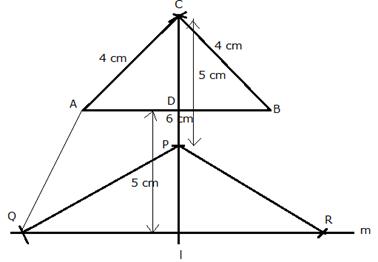
Steps of Construction:
i) Draw a line segment AB = 6 cm.
ii) With centers A and B and radius 4 cm, draw two arcs which intersect each other at C.
iii) Join CA and CB.
iv) Draw the angle bisector of angle C and cut off CP = 5 cm.
v) A line m is drawn parallel to AB at a distance of 5 cm.
vi) P as centre and radius 5 cm, draw arcs which intersect the line m at Q and R.
vii) Join PQ, PR and AQ.
Q and R are the required points.
Solution 7
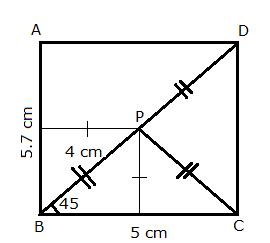
i) Steps of Construction:
1) Draw a line segment BC = 5 cm
2) B as centre and radius 4 cm draw an arc at an angle of 45 degrees from BC.
3) Join PC.
4) B and C as centers, draw two perpendiculars to BC.
5) P as centre and radius PC, cut an arc on the perpendicular on C at D.
6) D as centre, draw a line parallel to BC which intersects the perpendicular on B at A.
ABCD is the required rectangle such that P is equidistant from AB and BC (since BD is angle bisector of angle B) as well as C and D.
ii) On measuring AB = 5.7 cm
Solution 8
i. Steps of construction:
1. Draw BC = 6.5 cm using a ruler.
2. With B as center and radius equal to approximately half of BC, draw an arc that cuts the segment BC at Q.
3. With Q as center and same radius, cut the previous arc at P.
4. Join BP and extend it.
5. With B as center and radius 5 cm, draw an arc that cuts the arm PB to obtain point A.
6. Join AC to obtain ΔABC.
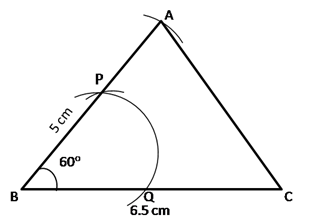
ii. With A as center and radius 3.5 cm, draw a circle.
The circumference of a circle is the required locus.
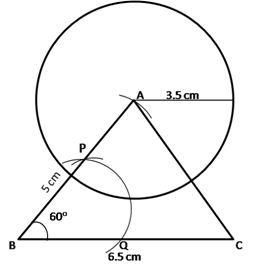
iii. Draw CH, which is bisector of angle ACB. CH is the required locus.
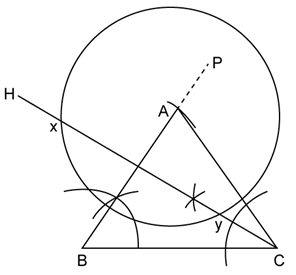
iv. Circle with center A having radius 3.5cm and line CH meet at points X and Y as shown in the figure. xy = 8.2 cm (approximately)
Loci (Locus and its Constructions) Exercise Ex. 16(B)
Solution 2
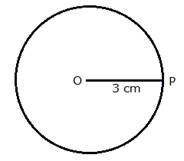
The locus of a point which is 3 cm away from a fixed point is circumference of a circle whose radius is 3 cm and the fixed point is the centre of the circle.
Solution 3
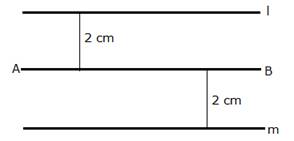
The locus of a point at a distance of 2 cm from a fixed line AB is a pair of straight lines l and m which are parallel to the given line at a distance of 2 cm.
Solution 4

The locus of the centre of a wheel, which is going straight along a level road will be a straight line parallel to the road at a distance equal to the radius of the wheel.
Solution 5

The locus of the moving end of the minute hand of the clock will be a circle where radius will be the length of the minute hand.
Solution 6
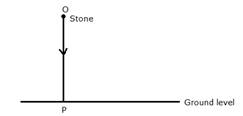
The locus of a stone which is dropped from the top of a tower will be a vertical line through the point from which the stone is dropped.
Solution 7
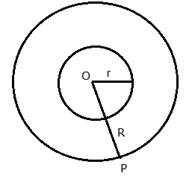
The locus of the runner, running around a circular track and always keeping a distance of 1.5 m from the inner edge will be the circumference of a circle whose radius is equal to the radius of the inner circular track plus 1.5 m.
Solution 8

The locus of the door handle will be the circumference of a circle with centre at the axis of rotation of the door and radius equal to the distance between the door handle and the axis of rotation of the door.
Solution 9
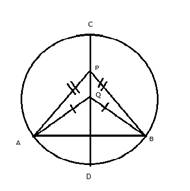
The locus of the points inside the circle which are equidistant from the fixed points on the circumference of a circle will be the diameter which is perpendicular bisector of the line joining the two fixed points on the circle.
Solution 10
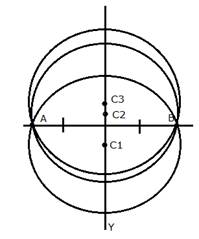
The locus of the centre of all the circles which pass through two fixed points will be the perpendicular bisector of the line segment joining the two given fixed points.
Solution 11
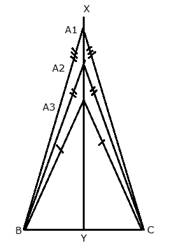
The locus of vertices of all isosceles triangles having a common base will be the perpendicular bisector of the common base of the triangles.
Solution 12
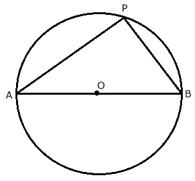
The locus of the point P is the
circumference of a circle with AB as diameter and satisfies the condition ![]() .
.
Solution 13
i)
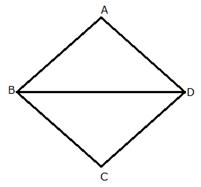
The locus of the point in a rhombus ABCD which is equidistant from AB and BC will be the diagonal BD.
ii)
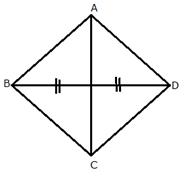
The locus of the point in a rhombus ABCD which is equidistant from B and D will be the diagonal AC.
Solution 14
i) The locus is the space inside of the circle whose radius is 3 cm and the centre is the fixed point which is given.
ii) The locus is the space outside of the circle whose radius is 4 cm and centre is the fixed point which is given.
iii) The locus is the space inside and circumference of the circle with a radius of 2.5 cm and the centre is the given fixed point.
iv) The locus is the space outside and circumference of the circle with a radius of 35 mm and the centre is the given fixed point.
v) The locus is the circumference of the circle concentric with the second circle whose radius is equal to the sum of the radii of the two given circles.
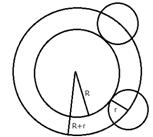
vi) The locus of the centre of all circles whose tangents are the arms of a given angle is the bisector of that angle.
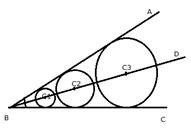
vii) The locus of the mid-points of the chords which are parallel to a given chords is the diameter perpendicular to the given chords.
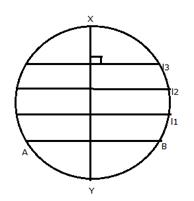
viii)The locus of the points within a circle which are equidistant from the end points of a given chord is the diameter which is perpendicular bisector of the given chord.
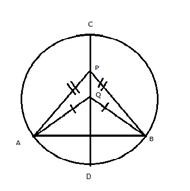
Solution 16
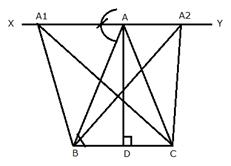
Draw a line XY parallel to the base BC from the vertex A.
This line is the locus of vertex A of all the triangles which have the base BC and length of altitude equal to AD.
Solution 15

Draw an angle bisector PQ and XY of angles formed by the lines m and n. From O, draw arcs with radius 2.5 cm, which intersect the angle bisectors at a, b, c and d respectively.
Hence, a, b, c and d are the required four points.
Solution 17
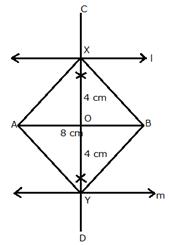
(i)Draw a line segment AB = 8 cm.
(ii)Draw two parallel lines land m to AB at a distance of 4 cm.
(iii)Draw the perpendicular bisector of AB which intersects the parallel lines land m at X and Y respectively then, X and Y are the required points.
(iv)Join AX, AY, BX and BY.
The figure AXBY is a square as its diagonals are equal and intersect at 90o.
Solution 18
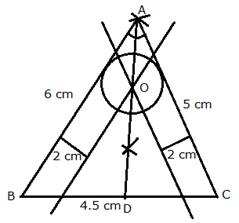
Steps of Construction:
i) Draw a line segment BC = 4.5 cm
ii) With B as centre and radius 6 cm and C as centre and radius 5 cm, draw arcs which intersect each other at A.
iii) Join AB and AC.
ABC is the required triangle.
iv) Draw the angle bisector of ![]()
v) Draw lines parallel to AB and AC at a distance of 2 cm, which intersect each other and AD at O.
vi) With centre O and radius 2 cm, draw a circle which touches AB and AC.
Solution 19
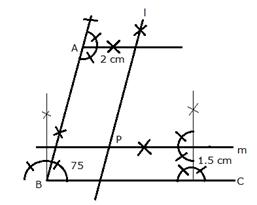
Steps of Construction:
i) Draw a ray BC.
ii) At B, draw a ray BA making an angle of ![]() with BC.
with BC.
iii) Draw a line l parallel to AB at a distance of 2 cm
iv) Draw another line m parallel to BC at a distance of 1.5 cm which intersects line l at P.
P is the required point.
Solution 20
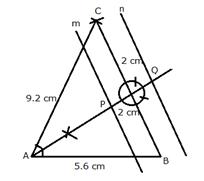
Steps of Construction:
i) Draw a line segment AB = 5.6 cm
ii) From A and B, as centers and radius 9.2 cm, make two arcs which intersect each other at C.
iii) Join CA and CB.
iv) Draw two lines n and m parallel to BC at a distance of 2 cm
v) Draw the angle bisector of ![]() which intersects m and n at P and Q respectively.
which intersects m and n at P and Q respectively.
P and Q are the required points which are equidistant from AB and AC.
On measuring the distance between P and Q is 4.3 cm.
Solution 21
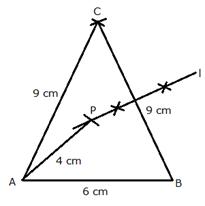
Steps of Construction:
i) Draw a line segment AB = 6 cm
ii) With A and B as centers and radius 9 cm, draw two arcs which intersect each other at C.
iii) Join AC and BC.
iv) Draw the perpendicular bisector of BC.
v) With A as centre and radius 4 cm, draw an arc which intersects the perpendicular bisector of BC at P.
P is the required point which is equidistant from B and C and at a distance of 4 cm from A.

